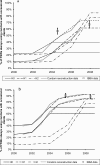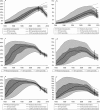Interim modelling analysis to validate reported increases in condom use and assess HIV infections averted among female sex workers and clients in southern India following a targeted HIV prevention programme
- PMID: 20167728
- PMCID: PMC3252612
- DOI: 10.1136/sti.2009.038950
Interim modelling analysis to validate reported increases in condom use and assess HIV infections averted among female sex workers and clients in southern India following a targeted HIV prevention programme
Abstract
Objectives: This study assesses whether the observed declines in HIV prevalence since the beginning of the 'Avahan' India HIV/AIDS prevention initiative are consistent with self-reported increases in condom use by female sex workers (FSWs) in two districts of southern India, and provides estimates of the fraction of new infections averted among FSWs and clients due to increases in condom use in commercial sex after 2004.
Methods: A deterministic compartmental model of HIV/sexually transmitted infection (STI) transmission incorporating heterogeneous sexual behaviour was developed, parameterised and fitted using data from two districts in Karnataka, India. Three hypotheses of condom use among FSWs were tested: (H(0)), that condom use increased in line with reported FSW survey data prior to the Avahan initiative but remained constant afterwards; (H(1)) that condom use increased following the Avahan initiative, in accordance with survey data; (H(2)) that condom use increased according to estimates derived from condom distribution data. The proportion of fits to HIV/STI prevalence data was examined to determine which hypothesis was most consistent.
Results: For Mysore 0/36/82.7 fits were identified per million parameter sets explored under hypothesis H(0)/H(1)/H(2), respectively, while for Belgaum 9.7/8.3/0 fits were identified. The HIV epidemics in Belgaum and Mysore are both declining. In Mysore, increases in condom use during commercial sex between 2004 and 2009 may have averted 31.2% to 47.4% of new HIV infections in FSWs, while in Belgaum it may have averted 24.8% to 43.2%, if there was an increase in condom use.
Discussion: Increased condom use following the Avahan intervention is likely to have played a role in curbing the HIV epidemic in Mysore. In Belgaum, given the limitations in available data, this method cannot be used alone to decide if there has been an increase in condom use.
Conflict of interest statement
Figures




Similar articles
-
Condom use and prevalence of syphilis and HIV among female sex workers in Andhra Pradesh, India - following a large-scale HIV prevention intervention.BMC Public Health. 2011 Dec 29;11 Suppl 6(Suppl 6):S1. doi: 10.1186/1471-2458-11-S6-S1. BMC Public Health. 2011. PMID: 22376071 Free PMC article.
-
Positive impact of a large-scale HIV prevention programme among female sex workers and clients in South India.AIDS. 2013 Jun 1;27(9):1449-60. doi: 10.1097/QAD.0b013e32835fba81. AIDS. 2013. PMID: 23462221 Free PMC article.
-
Programme coverage, condom use and STI treatment among FSWs in a large-scale HIV prevention programme: results from cross-sectional surveys in 22 districts in southern India.Sex Transm Infect. 2010 Feb;86 Suppl 1(Suppl_1):i62-8. doi: 10.1136/sti.2009.038760. Sex Transm Infect. 2010. PMID: 20167734 Free PMC article.
-
Global epidemiology of HIV among female sex workers: influence of structural determinants.Lancet. 2015 Jan 3;385(9962):55-71. doi: 10.1016/S0140-6736(14)60931-4. Epub 2014 Jul 22. Lancet. 2015. PMID: 25059947 Free PMC article. Review.
-
The distribution of new HIV infections by mode of exposure in Morocco.Sex Transm Infect. 2013 Nov;89 Suppl 3(Suppl 3):iii49-56. doi: 10.1136/sextrans-2012-050844. Epub 2013 Feb 14. Sex Transm Infect. 2013. PMID: 23413401 Free PMC article. Review.
Cited by
-
HIV prevention and care services for female sex workers: efficacy of a targeted community-based intervention in Burkina Faso.J Int AIDS Soc. 2015 Sep 14;18(1):20088. doi: 10.7448/IAS.18.1.20088. eCollection 2015. J Int AIDS Soc. 2015. PMID: 26374604 Free PMC article.
-
Positive impact of increases in condom use among female sex workers and clients in a medium HIV prevalence epidemic: modelling results from Project SIDA1/2/3 in Cotonou, Benin.PLoS One. 2014 Jul 21;9(7):e102643. doi: 10.1371/journal.pone.0102643. eCollection 2014. PLoS One. 2014. PMID: 25047804 Free PMC article.
-
Prevalence and incidence of HIV among female sex workers and their clients: modelling the potential effects of intervention in Rwanda.BMJ Glob Health. 2020 Aug;5(8):e002300. doi: 10.1136/bmjgh-2020-002300. BMJ Glob Health. 2020. PMID: 32764126 Free PMC article.
-
A dose-response relationship between exposure to a large-scale HIV preventive intervention and consistent condom use with different sexual partners of female sex workers in southern India.BMC Public Health. 2011 Dec 29;11 Suppl 6(Suppl 6):S8. doi: 10.1186/1471-2458-11-S6-S8. BMC Public Health. 2011. PMID: 22375863 Free PMC article.
-
Heterogeneity of the HIV epidemic in the general population of Karnataka state, south India.BMC Public Health. 2011 Dec 29;11 Suppl 6(Suppl 6):S13. doi: 10.1186/1471-2458-11-S6-S13. BMC Public Health. 2011. PMID: 22376218 Free PMC article.
References
-
- National AIDS Control Organisation, National Institute of Medical Statistics Ministry of Health and Family Welfare, Government of India. Technical report: India HIV estimates 2006. http://nacoonline.org/upload/NACO%20PDF/Technical%20Report%20on%20HIV%20... (accessed 22 May 2009).
-
- Avahan – the India AIDS initiative. The business of HIV prevention at scale. New Delhi: Bill & Melinda Gates Foundation, 2008. http://www.gatesfoundation.org/avahan/Documents/Avahan_HIVPrevention.pdf.
-
- Moses S, Ramesh BM, Nagelkerke NJ, et al. Impact of an intensive HIV prevention programme for female sex workers on HIV prevalence among antenatal clinic attenders in Karnataka state, south India: an ecological analysis. AIDS 2008;22(Suppl 5):S101–8. - PubMed
-
- Vickerman P, Foss AM, Pickles M, et al. Is the Indian HIV epidemic driven by commercial sex? A modelling analysis from south India. 18th ISSTDR: 28 June–1 July 2009, London. http://www.isstdrlondon2009.com.
-
- Chandrasekaran P, Dallabetta G, Loo V, et al. Evaluation design for large-scale HIV prevention programmes: the case of Avahan, the India AIDS initiative. AIDS 2008;22(Suppl 5):S1–15. - PubMed
Publication types
MeSH terms
LinkOut - more resources
Full Text Sources
Medical
